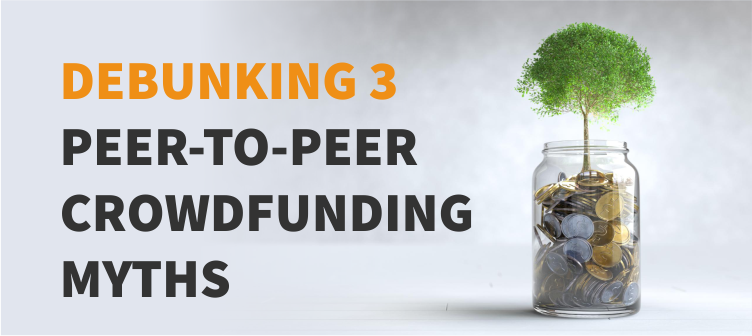
DEBUNKING 3 PEER-TO-PEER CROWDFUNDING MYTHS THAT SPOOK NONPROFITS


Busting myths, fears, misconceptions, and falsehoods about peer-to-peer fundraising
Here at Crowdera, we’ve seen firsthand that peer-to-peer fundraising can be a game-changer for nonprofit organizations, allowing them to leverage existing supporters to bring new supporters into the fold. But if your nonprofit organization has never attempted a peer-to-peer campaign before, it can be intimidating, even scary.
However, it can be intimidating and even frightening if your nonprofit organization has never tried a peer-to-peer campaign before.
Turning fundraising responsibilities over to your supporters seems, well, kind of nuts, right? We're here to let you know that it isn't! We'll be looking at typical worries, myths, and misconceptions about peer-to-peer fundraising in this blog and smashing them open wide.
If your organization is worried about fundraising, peer-to-peer fundraising might just be the thing that puts it back in the black!
1 Myth: With a peer-to-peer campaign, our nonprofit will lose track of our messaging.
Fundraising for nonprofits is an art. It takes good storytelling, an understanding of the variables that influence donor decision-making, marketing capabilities, and knowledge of nonprofit expansion to persuade individuals to donate. It's crucial to carefully craft your message, which is why your nonprofit has devoted countless hours to developing its brand and selecting the ideal language to describe its activities.
With a peer-to-peer campaign, your supporters take control of the narrative, so you run the risk of losing control of the message you've worked so hard to develop.
Reality: You can guide your fundraisers by providing resources for them.
Putting together a toolkit for your fundraisers- talking points, facts, sample emails, and social media posts- is a great way to help them communicate the important facts about your organization.
You can even provide social media share graphics and images to make sure your nonprofit stay on top of its cause's list. The information will enable them to have conversations with others about your nonprofit and stay focused on your cause.
These will help your fundraisers talk about the work your nonprofit does, enable them to have conversations with others about your nonprofit, and ensure that the message you've worked so hard to craft stays at the forefront of your campaign.
With Crowdera, a Peer-to-peer platform the owner approves the changes made by peers in the original content along with the option to make changes in the peer campaign. In simple words, the fundraiser will have full control over the campaign content with inbuilt social sharing options and a communication platform.
The reality of peer-to-peer fundraising is that while your nonprofit can't have total control over everything a fundraiser does or says in a peer-to-peer campaign, your nonprofit does have the ability to shape the message with some basic preparation.
2 Myth: Peer-to-peer campaigns are so hard to manage! Keeping track of fundraisers, providing support, and making sure everyone is on track is so much more work than just doing it ourselves.
Some fundraisers might need lots of hand-holding and support. You'll have to spend so much time managing this group of people. If you could just run your campaign with your paid, trained, and paid staff, you'd save a lot of time in the long run.
Reality: Running a peer-to-peer campaign requires the same amount of effort as running a traditional campaign, and sometimes less!
An essential fact about Crowdera is this: We support your nonprofit organization as well as your donors and fundraisers. By selecting Crowdera as your peer-to-peer fundraising platform, you agree to have a team of amiable customer service specialists supports your fundraisers and donors with technical and strategic support. It is true that the majority of the effort put into a peer-to-peer fundraising campaign goes into developing the toolkit we previously discussed. For fundraisers, that will be a one-stop shop that provides direction, responds to fundamental inquiries, and aids in efficient fundraising.
You can prepare a toolkit for a particular campaign (such as a team fundraiser) or have ongoing resources available for any other peer-to-peer opportunities that present themselves.
3 Myth: To succeed with a peer-to-peer campaign, your nonprofit must already have a large base of donors.
Your nonprofit might be new and in the process of expanding its donor base. You have a small group of devoted volunteers and supporters, but the majority of your funding comes from grants and donations from your select group of donors. Peer-to-peer campaigns seem to be something that larger nonprofits engage in rather than something that your small nonprofit can pursue.
Reality: Building your donor base through peer-to-peer fundraising is a great way of expanding your donor bandwidth.
Peer-to-peer fundraising is all about acquiring donors. That small group of people who support your nonprofit by giving money and volunteering? For a peer-to-peer campaign to be successful, they are all that is required.
Peer-to-peer fundraising functions fundamentally like community activism.
Even though a small or new nonprofit may not have the power or funds to compete with established ones or spend a lot of money on fundraising, it does have a purpose and supporters who care about what it does. They can encourage others to participate in your work if they spread the word about it and raise money and awareness. By giving, they give your nonprofit the chance to cultivate these new donors and persuade them to give once more.
4 Myth: To run a peer-to-peer fundraising campaign, you must host an event.
Peer-to-peer fundraising is often associated with events like charity walks, marathons, runway shows, galas, and other social gatherings. You're convinced that starting a peer-to-peer campaign for your nonprofit is unthinkable because you're not ready to host an event right now, whether it's because you lack the resources, personnel, or time to organize an event.
Reality: Peer-to-peer fundraising is possible without events, and there is more than one way to do the event.
When you consider peer-to-peer campaigns, charity walks and marathons come to mind because they are tested methods of raising money. Donors are aware of them, they function, and people can understand them. Are they essential for peer-to-peer campaigns, though?
No way! Without an associated event, a peer-to-peer campaign is still possible. Peer-to-peer fundraising can help you broaden your crowdfunding strategy and maintain the activities of your nonprofit organization when you aren't involved in major fundraising efforts or event preparedness. Likewise, peer-to-peer fundraising offers your supporters a unique, enjoyable way to support your nonprofit other than simply writing checks when you ask them to.
 Read Chinmaya Missions Successful peer-to-peer story. It’s entirely an online event, and raised over INR 2,31,67,659, just on our platform alone. We have seen time and time again that donors step up to participate in online campaigns in a big way.
Read Chinmaya Missions Successful peer-to-peer story. It’s entirely an online event, and raised over INR 2,31,67,659, just on our platform alone. We have seen time and time again that donors step up to participate in online campaigns in a big way.
It’s even easier for some people to participate online — they don’t have to attend an event, make a commitment, or walk or run. All they have to do is create a fundraiser and ask people to donate! You can use charity walks and marathons as inspiration to add structure, competition, and incentive to a peer-to-peer campaign you are organizing online, without the actual grunt work of organizing an in-person event. Peer-to-peer campaigns can fill the void between the events that your nonprofit has scheduled. Additionally, you can inspire your supporters to raise money for your nonprofit on their birthday, in observance of a special day or holiday, or simply for no particular reason.
Visit our blog site to know more about Peer-to-Peer
You can now book a free demo or schedule a call with our peer-to-peer experts after we've eliminated some common myths about peer-to-peer fundraising.
Interested in knowing more about fundraising platforms?






Leave a Reply or Comment